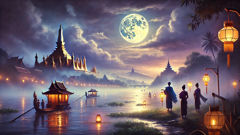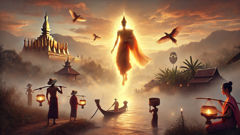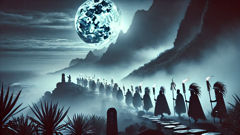Introduction
On the broad shoulders of the Mekong, where river mist unravels at dawn and gilded stupas pocket the horizon, the story of Phra Lak Phra Lam is spoken, sung, and performed in a thousand small ways. In villages where the rice terraces slope to the water and in city temples where saffron robes pool like sunlight, Lao people have carried a version of the Ramayana that belongs to their land: one embroidered with the cadence of Lao language, the cadence of chant and mor lam, and with the quiet philosophies of Theravada Buddhism. Phra Lam stands as the upright hero, noble and measured; Phra Lak, his brother and mirror, is fierce in loyalty and skill; Nang Sida is not simply the lost queen but a presence of tested virtue and sorrow. This epic is less about conquest of foreign lands than about steadiness under trial—karma met with compassion, duty met with wisdom. The telling shifts with each telling: puppet theater in Luang Prabang, masked dances at festivals, the low-lit hush of a village storyteller under a tamarind tree. There are battles that shimmer like storm-swept lacquerware and quiet scenes of offerings, Baci ceremonies, and chants. The myth survived through recited verses carved into lacquered manuscripts, through painted panels in wat cloisters, and through the breath of elders who taught the young how to hold courage in their hands. What you will read here is a retelling that honors Lao imagery and Buddhist thought, an imaginative, original meditation on an epic that shaped a nation’s view of heroism, compassion, and duty.
Origins and Landscape: How a Ramayana Became Lao
The story of Phra Lak Phra Lam did not arrive in Laos as a single book or a neat translation; it unfolded across centuries as a living current, shaped by travelers, monks, court poets, and the rhythm of rice planting and river travel. Ancient traders and itinerant scholars carried Sanskrit and Pali fragments and stories from the subcontinent. As these narratives entered the Mekong valley, they were braided with local motifs: the river’s temper, the stupa’s silence, and a ritual life organized around merit, respect for elders, and offerings to the spirits.
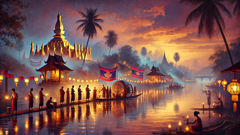
In the earliest Lao courts, reciters would perform in royal halls, their voices rising and falling in long, melancholy phrases. Over time, these performative pieces settled into fixed episodes—Phra Lam’s exile, the abduction of Nang Sida, expeditions across strange forests—and each retelling acquired local colors. Villagers adapted scenes to the human scale of their lives: monsters became spirits that drew on animist memory; forests became the great stands of teak and bamboo the people knew well; the hero’s bow became the idea of right action, a bow strung not only of yew wood but of vows, duty, and the unseen law of kamma. Lao Buddhist influence shaped the epic’s moral center. Where a purely Brahmanical telling might emphasize cosmic dharma and ritual kingship, the Lao version emphasized restraint, merits, and the soft authority of teaching over imperial might. Phra Lam’s decisions were judged not only by bravery but by right conduct—how he governed his anger, how he tended to the suffering of others, the way he performed rites to relieve spirits. Phra Lak, as brother and companion, embodied another Lao virtue: devotion in service, a willingness to step forward and shield the vulnerable without insistence on acclaim.
The landscape itself became a character. The Mekong, with its seasonal moods—full and ferocious in the wet months, patient and silvered during the dry season—framed journeys and choices. The epic’s journeys often follow riverbanks and mountain trails, moving between towns where thatched roofs cluster and the temple bells mark the hours of meditation. Scenes of festival and offering punctuate the narrative: villagers preparing sticky rice and banana leaf parcels, monks chanting beneath ancient trees, the Baci ceremony where strands of thread bind fortunes and restore balance. Textiles, lacquerware, and carved gongs appear as more than props; they are marks of identity, each object carrying memory, merit, and social threads. In weaving Phra Lak Phra Lam into Lao life, poets and performers created a mirror in which each listener saw the country’s values reflected back—kindness, the quiet endurance to do what is right even when the outcome is uncertain.
At the level of structure, the Lao epic preserves the sequence of trials, exile, abduction, alliance, and return familiar to Ramayana-type narratives, but it interprets each episode through a local temper. The antagonist forces—yaksha, ogres, or envious rulers—are often given motives that reflect human failings rather than metaphysical evil, and when they are defeated, the narrative’s focus shifts to restoration: restoring people to their homes, social order to the community, and balance to the natural sphere. The focus on restoration resonates with Lao Buddhist practice, which seeks the ease of the practical and the ethical rather than grand metaphysical pronouncements.
These features allowed Phra Lak Phra Lam to survive multiple transformations: oral recitations that changed line by line with a reciter’s impulses; courtly manuscripts that stabilized episodes in lacquered volumes; shadow puppetry and masked dance that enacted the tale for village festivals; and, in recent decades, theatrical revivals that reimagine the story for contemporary Lao audiences. In each form, the story remained alive because it responded to local life. When a flood came that year, storytellers emphasized the river’s trials; when famine struck, they dwelled on the lessons of charity and sharing. The epic functioned as a cultural reservoir—one where moral instruction, entertainment, and community memory gathered.
Understanding the epic’s Lao origin also requires attention to performance. The narrative’s meter and cadence respond to the Lao language’s musicality. A verse that wins approval in Vientiane may not suit the stylings of a storyteller in a remote district. Instruments such as the khene or the xylophone appear as anthems within the tale: a scene in which villagers wake to the khene’s exhortation and gather their household offerings is as much ritual as plot. Masked dancers, clothed in gilded cloth and mirror work, enact gods and ogres so that lines between mortal and divine blur on the stage. The masks are not merely costuming; they are portable shrines, and the dancers are vessels for ancestral memory.
As the epic moved across provinces, it acquired local versions and names. On the banks of the river in one province, an episode might highlight a fisherman’s cunning; in another, the same episode is recast as a moral lesson on humility. But a throughline remained: the epic’s central question asks how to live with duty and compassion, how to act rightly in a world of sorrow, and how to mend what’s broken through mindfulness and repair. That moral thread—thin but persistent—gives the Lao Ramayana meaning beyond spectacle and keeps it lodged in daily life, from temple murals to the hush of evening offerings.
To say Phra Lak Phra Lam is a national epic is not to freeze it in amber. It is to recognize a living tradition that continues to speak to Lao people wherever they gather. This telling, while rooted in ancient narrative bones, becomes Lao at every turn: in the specificities of local ritual, in the slant of the light over a rice field, and in the measured compassion of its heroes. It asks less what empire a man might found than how he keeps his head when the river rises and how he offers his hand to those swept downstream.
Heroes, Trials, and Buddhist Wisdom: Scenes from the Epic
The heart of Phra Lak Phra Lam beats in scenes where small human choices carry the weight of destiny. Unlike grand dynastic chronicles, the Lao epic makes room for private courage and the household virtues that sustain communities. In one early episode, Phra Lam accepts exile with a restraint that surprises those who expect kings to rage or to marshal armies. He bows to the obligation placed upon him—an oath of honor, a promise made at a hearth—and in doing so he models a Lao ideal: steadiness rather than spectacle. The narrative dramatizes this steadiness with simple but striking images: a brother binding a wound with his own sarong, a queen offering her last parcel of rice to a stranger, a monk who speaks a brief teaching at dusk.
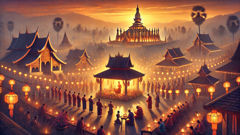
Phra Lak, who in other Ramayana versions stands as the devoted younger brother, is given a particular luminousness in Lao telling. His loyalty is an active force; he does not merely follow, he anticipates danger and sometimes acts as the agent who pushes the plot forward. There are sequences in which Phra Lak negotiates with river spirits, outwits a hostile ruler through cleverness rather than force, and leads rescue parties across fog-bound water. These scenes make him a cultural ideal of service: bravery married to humility. In their conversations, the brothers exchange teachings in the manner of dhamma reminders. Phra Lam might counsel restraint, while Phra Lak insists that action without suffering is empty. Together they perform a balance, a Lao-inflected dialectic between inner calm and righteous action.
Nang Sida’s role in the Lao epic has layers that reflect the society’s attitudes toward chastity, agency, and resilience. In Lao retellings, she is seldom a passive object of rescue; rather, she represents a moral center that tests the hero’s commitment. When abducted—or misled, in some versions—her endurance and cleverness become critical. She speaks to her captors with a calm that unsettles them; she invokes local spirits and offers small acts of compassion to those around her, even as she plots to preserve honor. Her presence highlights another Lao virtue: preserving face for the community and restoring harmony without spectacle.
The antagonists in Phra Lak Phra Lam are often drawn as tragic rather than purely evil. An envious chieftain who seeks to displace the rightful ruler is driven by fear and karmic blindness. A giant or demon is sometimes a once-human figure who has lost merit through greed. In telling their stories, the epic does not simply condemn; it shows a path toward redemption. Battles end not in triumphant annihilation but in rites that reintegrate or neutralize destructive energies—rituals of protection, offerings that clear the air, and the community’s acts of forgiveness that restore order. This focus on reintegration aligns the epic with Lao Buddhist practice, where purification and the accumulation of merit are essential remedies for suffering.
One of the most remarkable motifs in Lao performances is the way ritual and narrative overlap. Before an enactment of a crucial scene, performers themselves perform Baci rites to bind luck and to call spiritual protection. The community participates: the water is scented with jasmine; strands of white cotton are wrapped around wrists as villagers call out blessings. The stage is also an altar, and the performance functions as an act of communal reparation. Even the soundscape—gong, khene, and small cymbals—carries meaning. A particular khene motif signals a hero’s arrival; a solitary bell marks a moment of introspection. These sonic cues are as vital to the narrative as the verses themselves, and audiences internalize their meanings through repetition.
There are episodes that are uniquely Lao in their domestic detail. A scene where Phra Lam is tended by an old rice farmer who shares a story of ancestral perseverance becomes a moral parable about interdependence. In another, a village midwife’s quiet resourcefulness averts tragedy and is honored as a form of wisdom that the palace itself comes to respect. Such scenes underscored the epic’s democratic reach: greatness in the story does not belong solely to kings; it resides in small acts of right relationship.
Warfare in Phra Lak Phra Lam, when it comes, is shown as costly and sorrowful. The epic does not fetishize bloodshed. Military victories are followed by rites to honor the dead; mothers weep and are comforted by monks who teach impermanence and the proper way to commend the departed. Here again, Buddhist teaching is woven into narrative practice: death is no mere plot device but an occasion for reflection on samsara and the cultivation of compassion. The hero’s triumph, therefore, is never merely a scoreboard of enemies felled but a restoration of peace and balance.
In quieter moments, the epic becomes a manual for everyday living. A passage where Phra Lam declines an offer to amass wealth for himself and instead distributes grain to flood victims speaks louder than many war scenes. A parable inserted into a longer episode—an old monk telling a novice that merit grows like a tree, slowly and with patient tending—serves as a moral fulcrum. These insertions are not didactic interruptions; they are the narrative’s pulse. The epic moves between spectacle and small instruction so that living the tale becomes indistinguishable from learning it.
Over the centuries, artists and storytellers continued to find new ways to make these lessons visible. Mask-makers carved expressions into lacquer that captured a villain’s first doubt; dancers developed a step that signaled a hero’s internal turning. The story’s language adapted; the old courtly forms softened with peasant sayings, and the result is an epic that speaks clearly to ordinary people while preserving a lyrical dignity. Young listeners learn the verses by heart; elders teach the dances and the prayers that accompany them. The epic is, in that sense, pedagogy and prayer, entertainment and moral instruction. It is both a mirror and a map for living within the Lao world.
Contemporary Lao artists have continued this practice, reworking the epic in film, theater, and public art. Filmmakers emphasize the landscape’s centrality; poets amplify the dhamma lines. The narrative’s elasticity—its ability to hold many small truths without losing a coherent center—ensures that Phra Lak Phra Lam continues to be a resource for cultural self-understanding. It remains not just a story of kings and battles but a story about repair, about how communities bind their frayed edges after calamity, and how wisdom in the Lao sense—quiet, persistent, communal—outlasts the flash of conquest.
Conclusion
Phra Lak Phra Lam endures because it is not merely an ancient script but an ever-renewed conversation between story and society. Across dusty festival grounds, lacquered manuscript rooms, and the hush of wat courtyards, the epic teaches a Lao way of living—one that measures heroism by the steadiness of the heart, that values the repair of social bonds more than the spoils of victory, and that holds Buddhist compassion as a practical mode of action. When Phra Lam refuses rage and Phra Lak leaps to defend the vulnerable, they perform a lesson that ordinary people take into market stalls and rice paddies: that courage tempered by restraint and generosity is the true measure of greatness. Nang Sida’s resilience becomes a model for bearing sorrow without losing dignity. The antagonists’ eventual reintegration into social order speaks to a community ethic that prefers healing to annihilation. As Laos moves forward, its artists and storytellers will continue to reinterpret the epic, but the core remains: a story shaped by the Mekong, by ritual, and by a moral imagination rooted in Theravada principles. The myth will continue to appear when a village needs a lesson about moderation, when a temple needs to gather its people, or when a nation needs an image of itself—whole, patient, and capable of repairing what has been broken. To read Phra Lak Phra Lam as a Lao is to listen for the small, steady virtues that make life possible: generosity in scarcity, patience in hardship, and the resolve to act rightly so that future generations inherit not only story but the guidance to live well.

